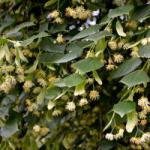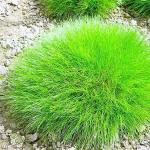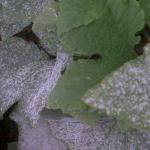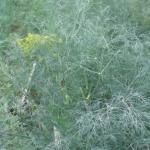Adonis (Adonis) is a genus from the Ranunculaceae family, represented by perennial and annual herbs - more than 30 species. It comes from the temperate zones of Eurasia.
Appearance and options for using adonis in garden decor
The genus contains both perennial and annual herbs.
The stem of the plant is straight, can be simple or branching. The leaves are pinnately or palmately dissected. Flowers solitary fiery red or bright yellow, placed at the tops of the stems. Flowering - end of April, beginning of June, depending on the species.
In summer, it is given decorative lacy leaves. A popular plant with landscape designers - used in group plantings or among trees and shrubs. Appropriate in flower borders, as well as in mixborders of medicinal herbs next to valerian and sage. When creating a flower garden from groups of flowers or medicinal herbs, plants should be planted nearby with the same requirements for growing conditions - light, soil, watering.Adonis looks good in a composition with stones or on an alpine slide.

The technology of growing adonis from seeds
Features of perennial cultivation technology:
- Seeds are harvested in June-July and immediately begin to plant.
- Seed germination is 30% - in the second year, germination weakens.
- Seeds are planted in nutritious, loosened soil to a depth of 1 to 1.5 cm.
- Seeds germinate under the film.
- Seedlings are expected on the 30-40th day or next spring.
- The distance between plants is 15 cm, between rows - 25.
- The soil is loosened and moistened.
Planting annuals:
- Choose a sunny or partly shaded location with moderately moist soil.
- Seeds are sown before winter in a permanent place. Planted in spring, they germinate in hot and dry weather - in the absence of shading, stunted, weakly flowering shoots are formed.

Seeds have a long germination period.
A reliable way to get high-quality planting material is seedlings. In this case, freshly harvested seeds are sown in boxes in rows in grooves to a depth of 1 cm, the distance between rows is 8-10 cm. Seedlings are grown both in open and protected ground. Immature seeds germinate in the same way as mature ones. Seedlings are transferred to a permanent place at 2-3 years of age.
Soil Requirements: Needs calcareous, nutritious, lime-containing soils. Grows best on black soil. It is important to ensure good drainage.
Important! The plant loves light areas. When shaded, growth does not stop, but blooms not as profusely as in the sun.
How to plant adonis (video)
Description of the types of Adonis (Adonis)
Varieties of Adonis serve as a source of raw materials for the production of cardiotonic preparations, osmotic diuretics (adonites). In folk medicine, they are used in the treatment of heart, stomach and nervous diseases.
Distributed in Central and Southern Russia. Adonis spring is a myrmecochorus plant - its seeds are spread by ants. It is widely used in traditional and folk medicine, due to the presence of cardiac glycosides, saponins, alcohols and specific acids.
Herbaceous perennial up to 60 cm high, with erect, weakly branching stems, with large yellow flowers, openwork, patterned leaves. The total life expectancy is from 120 to 150 years. Most flowers are formed by a middle-aged plant - about 30.

In Japan at the beginning of the 17th century, there were about 50 varieties of adonis that bloom in February. To this day, in the East, a tradition has been preserved to sell blooming adonis in pots for the New Year.
Amur Adonis is a rhizomatous perennial, common in Japan, Korea and the Far East. It blooms with bright yellow flowers immediately after the snow melts. In nature, orange and reddish flowers are found, with a bronze sheen of the outer petals. There are decorative terry and anemone forms.
In nurseries you can buy varieties:
- Benten - distinguished by white fringed flowers;
- Fukujukai - bright yellow, semi-double flowers;
- Sandanzaki - green petals in the center of a semi-double flower;
- Fukurokuji - large, yellow, terry balls;
- Ramosa - double copper-red flowers;
- Pleniflora - yellow-green terry.

Stem height up to 40 cm. Blooms within 2-4 weeks. When propagated by seeds, terry forms are not tied.
Growth zone - the European part of Russia, Western Siberia, Kazakhstan, steppes and forest-steppes. Perennial herbaceous plant with yellow flowers up to 4.5 cm in diameter, with a thick short rhizome. The pubescent leaves are dissected into lobes. Blooms in the last decade of April. On the 6-8th year blooms in culture. Has medicinal properties but less pronounced than in spring or Siberian Adonis.
Recently, adonis Turkestani and adonis golden, growing in the mountains of Central Asia, have been used in medicine. These two species differ from A. volzhsky in pinnately dissected leaves.

Cold-resistant herbaceous perennial with single pubescent stems, with oval double-pinnate leaves. The flowers are creamy white, with a purple tinge of the outer petals, up to 7 cm in diameter. Flowering in early May. As a rare species distributed in a limited area, listed in the Red Book. In culture, varieties with double flowers are used.

Perennial herbaceous summer green relict species. It grows in forest-steppe and forest zones from the Urals to Lake Baikal. As a valuable medicinal raw material, the entire aerial part is harvested in the period from the beginning of flowering to the moment of fruit shedding. Perennial with spring-early summer flowering rhythm. At the beginning of flowering, the stems are up to 30 cm tall, at the end - up to 60. The flowers are bright yellow, up to 6 cm in diameter, with numerous petals. Under optimal conditions, the bush grows and branches, forming many flowers. In dry places it has a squat appearance.

Annual, decorative throughout the summer. When thickened, branches in the upper part. In sparse plantings, it branches from each leaf axil, growing a spherical bush up to 50 cm high with bright red flowers and a black spot in the center. The petals contain a large amount of an effective antioxidant - astaxanthin. In culture, the variety "Kerubino" is used.

Golden Adonis (Adonis chrysocyathus)
Perennial herbaceous plant. It grows in Altai and in the highland meadows of the Pamirs, Tien Shan. Is in danger of extinction listed in the Red Book. Bush up to 40 cm tall with long-petiolate, thrice pinnate leaves. The flowers are golden yellow, outer petals with a purple tint.
Features of growing adonis (video)
Terms and technology of planting adonis
Adonis spring frost-resistant and unpretentious.
Breeds:
- Seeds - after harvesting, they are immediately sown in a garden bed, maintaining a distance between rows of 40-60 cm. Seedlings develop slowly for the first 2-3 years. Full flowering for 4-5 years.
- Rhizomes that are planted in summer or spring in moist soil. Each segment of the rhizome should have 2-3 renewal buds.
I have been cultivating in one place for no more than 10 years.

Adonis Care Secrets
Adonis, like all medicinal plants, does not require special labor and resources. The main requirements are imposed on the quality of the soil and lighting. The plant should be well lit by the sun and be protected from drafts. The soil is prepared by deep digging. In the spring, compost or humus is buried in the soil, in the fall - rotted manure. Mineral fertilizers are applied before sowing seeds, planting seedlings or before propagation by rhizomes. It is recommended to water the plants in the morning before 9 o'clock, or after 6 o'clock in the evening.
Soil acidity is determined by indicator plants. Horsetail, mint, Ivan-da-Marya, sorrel, plantain live on acidic soils. On slightly acidic and neutral, there are couch grass, coltsfoot, clover, odorless chamomile.
Useful properties of adonis (video)
Adonis is little damaged by diseases and pests. However, precautionary measures will not hurt. It is necessary to remove weeds and plant residues in a timely manner, carry out mulching of plantings and inter-row cultivation. Annuals are not desirable to be planted in the same place from year to year. Due to slow growth in the early years, it suffers from weeds. It is necessary to remove weeds and loosen the soil. In early spring, seeds are sown in the ground to produce cut flowers. In the cut branches with buds bloom and do not fade for a long time.
Adonis is a bright and unusual perennial belonging to the buttercup family. There are from 20 to 45 species in the genus, among which there are not only perennials, but also annual plants.
In nature, it grows in Asia, Europe, Russia and Ukraine in temperate regions. The plant does not like hot weather. It feels comfortable only in a cool climate.
General information
Adonis is the Latin botanical name for the flower. In our latitudes, it is called Adonis, for its bright yellow color and shape, reminiscent of a small sun. The plant got its Latin name in honor of Adonis, the son of the king of Cyprus, who was killed on a hunt by splashing his blood on the grass. In place of red drops, scarlet flowers grew, called adonis. However, there are very few varieties with red petals, mostly adonis have a yellow tint.
There is also a second legend. Allegedly, the flower was named after the Assyrian deity Adon, who loved these bright flowers. Among gardeners, adonis began to be popular only at the end of the 17th century. Since then, it has been used not only in gardening, but also in landscape design, as a decoration for alpine slides and flower beds.
The plant is listed in the Red Book, as the species is endangered.

Adonis species and varieties
is an ornamental plant cultivated since the beginning of the sixteenth century. In the wild, it grows in Europe, Kazakhstan, Siberia, Crimea and Ciscaucasia. The flower has branched ribbed shoots extending from the bush in large numbers.
When the plant blooms, its length reaches 20 centimeters, and after a while, it grows up to 60 centimeters. Adonis has palmately divided narrow leaf blades. Inflorescences have a bright yellow tint. Flowers appear from 4 to 6 years of life. The plant blooms for only 15 days, from late April to mid-May.

- in the wild, adonis can be found in the Far East, in Japan and China. The bush reaches a length of 12 centimeters and has pinnately dissected foliage of a green hue. Flowers have a yellow-golden hue and a diameter of up to 5 centimeters. Flowering time falls on the beginning of April and ends in mid-May.

- the birthplace of this variety of Adonis is Mongolia, Eastern and Western Siberia. The height of the bush reaches 60 centimeters. The leaves are pinnate, dark green. Inflorescences are bright yellow with a diameter of 6 centimeters. Adonis blooms in late May or early June.

- is a perennial herbaceous plant, reaching a height of 60 centimeters. The leaf plates are thick, silky with light felt pubescence. Flowers are large, crimson red. Adonis blooms in May.

- an annual plant, reaching a height of half a meter. This variety is very similar to poppies, so it is easy to confuse it with them. The leaves are densely dissected, needle-shaped, dark green in color. The flowers are bright red with a black spot in the middle. Flowering time is June-August.

The plant reaches a height of up to 30 centimeters. Adonis has few branches, but they are densely pubescent with dark green needle-like leaves. Inflorescences have a light yellow hue with purple pubescent sepals. Adonis blooms in late May or early July.

- in nature, the plant is found in Siberia, Kazakhstan. It reaches a height of 15 centimeters and has pinnate oval-shaped leaf plates. Flowers have a light yellow tint and have a diameter of 5 centimeters. The plant blooms from early to mid-May.

- is a herbaceous annual growing in the Mediterranean. The plant reaches a height of 30 centimeters and has thinly dissected, dark green leaf plates. This variety has large yellow or red inflorescences with a black center with petals closed to the top. Adonis of this variety has been cultivated since 1596.

- the plant will grow in Russia, Asia and Western Europe. Adonis has straight, branched stems with double-dissected, narrow leaf blades. It has single small inflorescences of bright red color with a dark spot in the middle. Adonis blooms in June or August.

- this variety is found in Ukraine, the Caucasus and the Crimea. It is a herbaceous annual, reaching a height of 50 centimeters. Leaf plates are pinnately dissected, dark green in color with dense pubescence. Inflorescences are bright red with a dark spot in the middle. Adonis blooms at the end of May - beginning of June.

Adonis planting and care in the open field
Having decided to grow adonis on your site, you should remember that the plant does not tolerate shade, and loves the sun very much. However, direct sunlight is harmful to him, so it is better to plant him next to tall "comrades" who will slightly shade him. Both perennials and annuals can adapt to light but not heavy shade. If the adonis is in the shade, it will stop blooming, growing and developing.
Plants are not too demanding on the soil, but it is best to plant them in fertile soil, while not forgetting to systematically water and loosen the soil in the garden with flowers, then Adonis will feel comfortable.
Planting young adonis in open ground should be carried out at the end of April, when the threat of frost disappears. If, however, not seedlings are used for planting, but seeds, then they need to be planted in a greenhouse, doing this in March. A bed for adonis must be selected so that direct sunlight does not fall on it.
Light penumbra is considered ideal. Also, the landing site must be protected from wind and drafts, otherwise young plants may die.
Planting adonis
Seedlings are planted in fertile soil. The substrate for Adonis should be well drained. This will avoid stagnant water in the root system and improve the penetration of air through the soil.
Seedlings must be planted at a distance of at least 25 centimeters from each other, carefully spreading the root system to avoid damaging it. Planting holes should be at least 5 centimeters deep so that the roots are well deepened into the ground.
After placing the young in the holes, the plants should be sprinkled with earth and watered, and then the bed should be mulched with a mixture of peat and straw.
Erantis or springweed also belongs to the Ranunculaceae family. It is grown during planting and care in the open field without much hassle, if you follow the rules of agricultural technology. You can find all the necessary recommendations in this article.

Watering adonis
For many adonis growers, the biggest challenge is watering the plant. Adonis in terms of moisture prefer stability. Thus, the flower should be provided with regular watering, but waterlogging should not be allowed, otherwise the root system will begin to rot and the flower will die.
In rainy summers, the plant can not be watered. It will be enough just to loosen the soil and break through the weeds. During a drought, liquid should be applied under the adonis bushes systematically, making sure that the soil is slightly moist.

soil for adonis
Picking up the soil for the normal growth and development of adonis is a very difficult task. It should be fertile, with a lot of organic matter, but at the same time light and loose. Adonis is suitable for calcareous soil.
Before planting plants, the soil in the garden must be mixed with organic matter (compost) and a small portion of lime.

Adonis transplant
The transplant is difficult for the plant, so it should be carried out only in extreme cases. If this procedure is still necessary, the adonis must be carefully dug up and transferred with a large earthen clod to a previously prepared place.
Transplantation should be carried out in late summer or early autumn, when the growing season of the adonis comes to an end.

Feeding adonis
Both annuals and perennials need timely fertilization. Top dressing is necessary to maintain a high nutritional value of the soil. Fertilize the plant twice a season.
The first time it is necessary to apply mineral fertilizers when the flower begins to actively build up deciduous mass and release buds.
The second time you need to feed adonis at the end of the growing season. To the basic mineral top dressing, you should add a couple of top dressings with organic fertilizers, in the form of mulching, compost and humus.

Adonis bloom
The flowering period of Adonis is short. It lasts only 15 days. The plant usually blooms from late April to mid-May. But there are varieties that bloom from late summer to early autumn.
Most of the inflorescences of Adonis have a sunny bright yellow color, but there are also varieties with red petals and a dark spot inside. This color makes Adonis outwardly similar to poppies.

pruning adonis
When pruning a plant, you should be extremely careful. If the gardener is not sure that he can remove dry branches and buds without damaging the plant, then it is better to abandon the procedure altogether.
Caution should be observed due to the fact that the adonis lays growth buds not only for the next season, but also for 3-4 seasons ahead, so it is very easy to damage them, and if this happens, the plant will not be able to develop or even die.
When removing dry shoots, it is necessary to leave "hemp" without cutting off the adonis at the root. Thus, it will be possible to avoid injury to the kidneys, while maintaining the plant's normal vital activity until the next season.

Preparing Adonis for Winter
Since the plant is characterized by increased frost resistance, it can not be covered for the winter. However, if these are young adonis obtained by bush division or seeds sown in the ground in autumn, they must be covered with a thick layer of peat and covered with spruce branches on top.
After a year, when the young adonis get stronger, there will be no need to prepare them for winter.

Reproduction of adonis by dividing the bush
Adonises reproduce by bush division and seed method. For transplant division, you should choose a plant whose age is at least 5 years. The procedure for disembarking delenok is carried out in late summer - early autumn.
Selected mother bushes must be divided into 2-3 viable seedlings. The division must be carried out carefully so as not to damage the root system and the earthen ball around the plants.
After separation, the seedlings should be planted in the prepared area, shaded and watered systematically until they adapt to the new location. Since Adonises do not tolerate transplanting well, they will adapt slowly, and will bloom only after a few years.

Adonis growing from seeds
Seed propagation is a very laborious method, since the seeds of Adonis have a very low degree of germination, and it also happens that seeds planted in open ground germinate only a year after planting. Only fresh seed material collected after the end of the growing season of the plant is suitable for sowing.
Before sowing the seeds in the prepared substrate, they should be cleaned and scattered in a box, and only then covered with soil. Until the onset of winter, the seeds should be kept in a cold room. Seedlings grow very slowly, causing a lot of trouble to the gardener, and young plants bloom only after 5 years after planting in open ground.
Annual plants reproduce only by seed. They are sown before winter in the substrate or at the end of April in open ground. Adonis are rarely grown in pots.
Sowing seeds should be carried out in rows, leaving 30 centimeters between them. A month after sowing, the seedlings should be dived and transferred to a light, high-quality and fertile open ground. After planting, young plants must be shaded and watered abundantly.

Diseases and pests
Since adonis is a very poisonous plant, it is bypassed not only by pests, but also by diseases that threaten garden flowers.

Why is adonis listed in the Red Book
Due to the fact that Adonis is a medicinal plant, people who are fond of folk methods of treatment collect it in its natural habitat before the seeds ripen. This leads to a reduction in the natural propagation of the plant by seed.
As a result of improper harvesting of raw materials of Adonis, or rather, pulling out shoots, which is absolutely impossible to do, growth buds are damaged, which accordingly leads to a decrease in the yield of aerial leaf and flower mass of adonis.
All these negative factors lead to the depletion and disappearance of natural adonis thickets. It is for this reason that adonis was listed in the Red Book, to save the "solar flower" from complete destruction.

Adonis medicinal properties and contraindications
Without exception, all plant varieties have medicinal properties. However, not all adonis is used for the preparation of medicines, but only its aerial part. In order for the raw material to bring maximum benefit, it should be collected only on dry and sunny days during the flowering of the adonis.
Dry the plant, after spreading it in a thin layer in a shaded place. Dried grass should be stored in cloth bags or paper bags for three years. The longer a dry plant is stored, the less effective it becomes.
Adonis is used in the treatment of many diseases, but they are most effective for:
- Heart problems - decoctions of adonis are used for hypotension, tachycardia and heart defects, accompanied by edema and shortness of breath.
- Diseases associated with CNS damage - the plant has a mild sedative effect, so it is prescribed for psychosis, neurosis and the withdrawal of patients from binge drinking and the state of drug intoxication (withdrawal), which is accompanied by inappropriate behavior and suicidal thoughts.
- Infectious lesions of the urinary system - Adonis is used for cystitis and pyelonephritis as an anti-inflammatory and diuretic.
- Diseases of infectious etiology - the plant is used to prepare decoctions used for sore throats, coughs and bronchitis.
- Rheumatic joint disorders - decoctions and tinctures based on adonis help relieve pain and inflammation characteristic of rheumatoid arthritis.
Despite the fact that Adonis is very useful for the body and allows you to fight many diseases, there are also contraindications, in the presence of which it is forbidden to take Adonis-based products. These include ailments presented by:
- stomach ulcer;
- Inflammation of the gastrointestinal tract;
- hypertension;
- Gastritis.
- Atherosclerotic vascular changes;
- Bearing a fetus.
Adonis belongs to the category of potent, poisonous plants. Therefore, all funds based on it should be prescribed by a specialist, taking into account acceptable dosages. Consultation is mandatory for patients with cardiovascular diseases.

Adonis use in traditional medicine
Not only in folk, but also in traditional medicine, adonis is used as a raw material for medicines represented by:
- Bekhterev's medicine - This herbal remedy is a sedative.
- Cardiovalen - the drug is used to treat diseases of the central nervous system.
- Adonis bromine - Phytopreparation is used to treat diseases of the cardiovascular system.
In folk medicine, the plant is used to prepare decoctions and tinctures. Among them there are several effective remedies, the recipes of which will be presented below.

Spring adonis herb infusion for insomnia
To prepare the product, you should take 25 grams of dry Adonis raw materials, pour it into a glass jar and pour 200 milliliters of vodka. Then the mixture must be closed with a lid, shaken and put in a dark place for 14 days.
After this time, the tincture should be filtered and taken before going to bed, 20 drops for a month. After completing the full treatment course, sleep problems disappear.

Adonis decoction for heart disease
To prepare an adonis broth, you need to take 35 grams of dry raw materials and pour it with a glass of boiling water, leaving it to infuse for 30 minutes.
When the broth is infused and cooled, it should be filtered and taken 1 tbsp. spoon three times a day for a month. Since the course of treatment depends on the severity of the disease, it is necessary to consult a doctor about its duration.

Should the lower abdomen hurt during treatment with adonis
This side effect is often experienced by the fair sex if they take drugs based on adonis during menstruation.
Pain sensations appear because the composition of the plant includes substances that lead to contraction of the walls of the uterus, and, accordingly, pain. It is for this reason that preparations based on adonis should not be taken by expectant mothers, since the plant extract will lead to miscarriage.
Despite the fact that adonis is not easy to care for, many gardeners choose it as the decor of their garden plot. And not in vain, because in addition to its magnificent decorative qualities, the plant is also a medicine that saves from many ailments. Therefore, those gardeners who decide to decorate their plot with adonis will remain in the black.
Adonis has been used in landscape design since the late 18th century. Before that, it was considered a wild plant, unsuitable for flower beds and home gardens.
This is a member of the Buttercup family. It is used not only for decoration, but also for the treatment of diseases. It has lush curtains strewn with red or yellow inflorescences. It has bright, pinnate or palmately divided leaves that densely cover the stem. The older the plant, the more branches it forms. The flower retains an attractive appearance even after it fades.
There are several types of flowers. They bloom at different times. One is in the spring, the other in the summer. Summer blooms petals in the middle of the season and continues to bloom until autumn. There are both annual and perennial species.
Gardeners rarely use the seed method of growing adonis due to low seed germination. In addition, young shoots grow and develop poorly. But if you want to try to grow a flower in this way, then you should adhere to the following rules:
- Sow seeds in mid or late spring.
- Seeds must be stratified before sowing.
- Young plants can be planted in a permanent place 1 after germination. Before that, they must be in the school for growing.
Before sowing, mix adonis seeds with sand, scatter on the surface of the soil, cover with a small layer of foliage.
Popular types
Adonis Amur. In nature, the flower lives on the northern and eastern slopes of the hills of Japan, Transbaikalia and Primorye. Be sure to consider this circumstance when choosing a place in the garden or flower garden. In open sunny places, the plant feels uncomfortable. The Amur flower has a large number of yellow flowers that open immediately after the snow melts. In the summer, mulch its base with leaves or grass, as it does not tolerate heat well.
Adonis spring. In nature, the flower grows in glades, on the edges and in the steppe. In Russia, it is not common, since in the last century it was actively harvested as a medicinal plant. Spring Adonis inflorescences reach 4-6 cm in diameter. They are yellow, without too much brightness. Propagated by plant division of the bush. In the garden, the flower is also rarely grown. Preference is given to the Amur species, because it has brighter flowers and more beautiful leaves.
For propagation, divide the bush only into 2 parts, keeping the soil ball. Try to be careful with the roots.
Planting rules
- Adonis thrives in lightly shaded, well-ventilated areas.
- When planting a flower on an alpine hill, take them to the western and eastern sides.
- The soil for planting should be as light as possible, with the addition of organic fertilizers. The acidity of the soil is neutral. Suitable soil with a high content of calcareous substances.
- Before planting, loosen the soil well, fertilize it.

Do not use mineral fertilizers when planting adonis! The plant does not tolerate them well.
Care rules
Caring for flowers is not particularly difficult.
Watering
During spring and summer, the area where adonis grows must be regularly moistened and loosened. If the weather is wet, watering can be avoided.. The optimal watering schedule in hot and dry weather is 3 times a week. You can water under the root or irrigate the plant from above.
Be sure to loosen the soil after watering. Do this carefully, as the adonis will plant renewal buds close to the ground surface. If they are damaged, the flowering time of the crop is reduced. In some cases, this provokes his complete death.
top dressing
It is necessary to feed the flowers exclusively with organic fertilizers. And you need to do this during landing. The rest of the time the plant does not need to be fed.
 Adonis is a flower listed in the Red Book.
Adonis is a flower listed in the Red Book. Preparing for winter
Tolerates severe frosts, therefore, it does not need special preparation for winter. The only exceptions are young plants (up to 2 years). Their root system must be covered with fallen leaves or withered grass.
Diseases and pests
This is a poisonous plant, so pests rarely infect it. He is not afraid of illness. While neighboring flowering crops can be completely attacked by pathogens, it retains an attractive appearance.
Application in landscape design
Looks good on rocky hills, along a dry stream or garden path. It will also decorate rockeries and flower beds. It can be combined with:
- violets;
- hazel grouse;
- iris;
- phlox;
- decorative bow.
Adonis is a beautiful and unpretentious flower that loves partial shade and light soil. It blooms almost the entire season, it is not afraid of diseases and pests. For a gardener who cannot devote much time to the site, he will be a real find.
The main thing that gardeners love the spring adonis plant for is its durability. In one place, these flowers can grow up to fifty years and annually delight plant growers with lush, sunny flowering. If you plant even one small bush, after a couple of years it will grow so that it forms a small curtain of 20-30 bright flowers. The only negative is the poor germination of seeds, so it is recommended to propagate adonis by dividing the rhizome.
Description of the plant Adonis spring
Spring Adonis, or Adonis (Ranunculaceae family) is naturally distributed in Central and Southern Europe, Altai, and Siberia.
According to ancient Greek myth, these flowers were named after the beautiful Adonis, the lover of the goddess of love, Aphrodite. He was mortally wounded while hunting by a wild boar. Seeing the inconsolable grief of the goddess, Hades, the lord of the kingdom of shadows, began to let Adonis go to the earth, where he spent six months, and then returned back to the kingdom of the dead. When Adonis came to earth with the first bright rays of the spring sun, nature came to life, and where he stepped, blossomed. They became the personification of nature, joy and love resurrecting every year.
Below you can see the photo and read the description of the spring adonis growing in the middle lane:


This is a low-growing rhizome that blooms in early spring with golden yellow flowers 2-3 cm in diameter. The stems are straight, smooth, slightly branched, about 20-30 cm high.
As you can see in the photo, the spring adonis (Adonis) has single flowers with "lacquer" petals:


Each flower lives 8-10 days, opening early in the morning and closing in the afternoon. On cloudy days, flowers may not open at all. When the plant fades, finely dissected filamentous leaves appear. Seeds ripen in June.


Even one plant eventually forms a curtain. Adonis reach their maximum development by about 40-50 years. By this time, up to 30 large flowers are formed annually on the plant.
Growing and using adonis spring
When growing adonis flowers, you need to take care of drained, well-fertilized, sufficiently moist soil. Prefers open sunny places, but tolerates partial shade well. Watering is necessary in hot weather and top dressing before flowering and in July (for laying flower buds). The plant is winter-hardy.
Adonis is propagated by dividing the rhizome in the spring, after flowering. You can divide the plant no earlier than after 5-7 years. Seed propagation is rather difficult. Seed germination is very low, and seedlings are not hardy, grow slowly and bloom only in the fourth or fifth year.


Grow in rock gardens singly or small. The bushes of adonis are especially attractive among the blueberries and liverworts.


Adonis spring is not only decorative, but also a valuable medicinal plant. The use of spring adonis in folk medicine is recommended for diseases of the heart and kidneys. Adonis preparations were introduced into official medicine at the end of the 19th century. the famous clinician S.P. Botkin. Cardiac glycosides extracted from the aerial parts of the plant are used for chronic heart failure, cardioneurosis, and in combination with bromine - for increased nervous excitability, insomnia and epilepsy.
Adonis is native to the temperate regions of Eurasia. There are 45 types of Adonis. Perennial and annual plants with branched stems. Adonis foliage is pinnate or palmately divided into narrow lobes. The flowers are red, yellow, solitary, located at the ends of the shoots. The fruit of adonis is a leaflet. Its seeds are wrinkled with a bent or straight nose.
Types, varieties of adonis
Of the perennial adonis in horticulture, the most common are:
Adonis Volga
Homeland - Europe, Siberia, Central Asia. It grows in the steppes, on forest edges.
Perennial with a short, thick, brown-black rhizome. The stems of the Volga Adonis are not numerous, 30 cm in height, branched from the middle, at the base with brown scaly foliage. The flowers of the Volga Adonis are pale yellow. Sepals pubescent, lilac. Fruits in a rounded head. Achenes finely wrinkled, hairy.

Adonis amur
The homeland is the Far East, Japan, China, the Korean Peninsula. It grows in forests on clearings, on the slopes of the banks, on rich humus soil.
Forest perennial plant with feathery foliage on high petioles. Like bulbous flowers, the growing season ends in summer. The height of the plant during flowering is not more than 12 cm. The flowers of Amur Adonis are golden, wide open, 5 cm in diameter. The flowers tend to appear earlier than the foliage, which lasts until the end of summer.

At this time, the plant reaches 30 cm in height. The aerial part dies completely in July. Amur Adonis flowers are very sensitive to temperature changes: in cold weather they close.
Amur adonis needs humus-rich soil, partial shade and plenty of moisture, it is best to plant the plant in a grove. Propagated only by division, because in European conditions it does not give seed germination.
In Vladivostok, cover with foliage and snow is necessary. Flowering occurs in March.
Adonis amur poisonous . The plant is interesting as an early honey plant.
Adonis Amur is well known in culture. There are Japanese varieties, and even terry ones.

Adonis spring
Perennial. Spring Adonis has a thick rhizome and a huge number of ribbed, simple stems that grow 15 cm, and then reach 60 cm. At the bottom of the stem there are brown scales, and renewal buds are laid in their axils. The foliage of spring Adonis is palmately separate, with narrow lobes. Single flowers with 12 yellow petals. The fruit is nuts attached to an elongated receptacle. Among the people, spring adonis is also called yellow flower, starodubka, Montenegrin.

Spring Adonis is common in the forest-steppe regions of Eastern and Central Europe. It grows in glades, on hills, edges, in the northern steppes. Spring Adonis loves chernozem soils, open and drained areas.
On the site for the plant, you need to choose a place with fertile soil containing lime. It is important to provide drainage and soil moisture. Adonis is a photophilous plant. The plant may die due to lack of light. The main difficulty in growing adonis is that it does not take root very well.

Adonis sibirica
Grows in Russia, in Siberia.
Perennial 60 cm with pinnately divided foliage and yellow flowers. Flowering occurs in May. Siberian Adonis seeds ripen in July. There are decorative varieties with brown flowers. Siberian Adonis develops well in open areas.
Adonis fluffy
Homeland Kazakhstan, Siberia. It grows in the plain steppes, on the edges.
The stems of downy adonis are solitary, when they begin to bloom they are densely hairy, then lengthening 30 cm and becoming scattered hairy. The flowers of the downy adonis are pale yellow. Fruit heads are ovoid or spherical, on deflected legs. Achenes hairy, wrinkled, oval.

Location of adonis: perennial adonis are all winter-hardy, grow with good success in sunny as well as shaded places. Good development is achieved in lighted areas with little shading at noon.
Adonis soil
For lush flowering, adonis requires soil rich in lime and organic matter.

Adonis Care
It grows slowly and is sensitive to transplants. The soil must be kept moist and loose. Renewal buds in Adonis are laid for several years in advance, so it is necessary to cut off carefully, trying not to harm the kidneys.
Reproduction of adonis
The division of the bush and seeds. It is necessary to plant in August so that the plants can take root before frost. Adonis transplantation does not need to be done before 4 years of cultivation, sometimes they grow up to 10 years in one place. The best option is to transplant adonis with a clod of earth, it grows slowly, it is not recommended to divide it into small parts. Propagation of Adonis seeds is difficult, because the seeds have a low germination rate, yet, some of the seeds germinate the next year. Sowing seeds should be done immediately after harvest.

Use of Adonis
Adonis is unsuitable for cutting, but it is very beautiful in group plantings, among shrubs. When planting, it should be planted closer to the paths, it is also effective on alpine slides.
Adonis Partners
It goes well with magonia, thuja, yew and boxwood. Effective with primroses, anemones, arabis, and other early flowering plants.


















